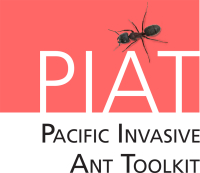Insect growth regulators (IGRs)
Insect growth regulators are chemicals that interfere with insect development in the egg and during the larval and pupal stages. IGRs prevent the insect from reaching adulthood and reproducing - effectively sterilising the population. With ants, this means sterilising the queen.
While they have less potential to affect the health of animals and people, in the short-term IGRs do not kill the adults that are causing the problem in the first place, so it is a good idea to use them with another pesticide as part of an integrated pest control programme.
Three classes of Insect Growth Regulators
IGRs may be broadly divided into three categories:
- Juvenile hormone mimics (used in ants): juvenile hormone prevents the insect from reaching its next developmental stage after a moult, meaning it is prevented from reaching adulthood and in the case of the queen reproducing
- Anti-juvenile hormones (not used in ants): these block juvenile hormone uptake, causing the larva to moult too early, retain juvenile characteristics into adulthood and preventing reproduction
- Chitin synthesis inhibitors (not used in ants): these inhibit the formation of a new exoskeleton after a moult and interfere with egg development ultimately causing mortality.
IGRs used for controlling ants are mostly juvenile hormone mimics and include S-methoprene, pyriproxyfen and fenoxycarb.
S-methoprene : Pyriproxifen : Fenoxycarb
S-methoprene
Detailed information about S-methoprene and its environmental fate is available in this publication, which is summarised below.
Methoprene is an insect growth regulator that comes in two different forms: S-methoprene and R-methoprene.
S-methoprene is a juvenile hormone mimic, which prevents insects from reaching adulthood and reproducing. S-methoprene is found in a number of IGRs used on ants including Engage® P.
Breakdown in soil
Methoprene binds with soil and is therefore expected to be immobile. Half of the methoprene is expected to be broken down in 10 days in both sand and silty loam soils. It has the potential to evaporate at 25ºC, but soil binding is likely to stop this. Sunlight also breaks methoprene down rapidly
Breakdown in water
In water, methoprene is quickly broken down by sunlight. The compound tends to bind with aquatic sediments.
Non-target effects
Because methoprene breaks down rapidly in the environment, it is believed to pose relatively little risk to non-target species and is quickly metabolised by fish, birds and mammals.
Methoprene is moderately toxic to cold water fish and non-toxic to warm water fish. However, accumulation of the toxin has been observed in the edible tissues of crayfish and sunfish.
Information sources
Csondes. 2004. Environmental fate of methoprene. Report for Department of Pesticide Regulation California Environmental Protection Agency Environmental Monitoring Branch
Pyriproxyfen
Detailed information about pyriproxyfen and its environmental fate is available in this publication, which is summarised below.
Pyriproxyfen is a broad spectrum IGR (insect growth regulator). It mimics the juvenile hormone and overloads the insect’s system causing it to continue to grow in its larval form without moulting- typically leading to the death of the larva.
Breakdown in soil
Pyriproxyfen breaks down rapidly when air is present in soil. Half of the compound will break down in 6.5 days under these conditions. When applied to bare ground pyriproxyfen has been found to be stable in the top 15 cm of soil for up to a year.
Breakdown in water
In water, pyriproxyfen absorbs into organic matter and remains active (ie it will still affect insects’ and crabs’ growth) for about two months. In the absence of organic matter its break down is accelerated by increased temperature and exposure to light.
Non-target effects
Crabs and other crustaceans are sensitive to the effects of pyriproxyfen, which result in reproductive development abnormalities coupled with build-up of the toxin in the edible tissues. For this reason it is not recommended that pyriproxyfen is used to control ants in areas where land crab species are present.
Information sources
Linton, Barrow, Davies, Harman. 2009. Potential endocrine disruption of ovary synthesis in the Christmas Island red crab Gecarcoidea natalis by the insecticide pyriproxyfen. Comparative Biochemistry and Phyiology Part A 154:289-297
Sullivan. 2000. Environmental fate of pyriproxyfen. Report for Department of Pesticide Regulation California Environmental Protection Agency Environmental Monitoring Branch
Fenoxycarb
Detailed information about fenoxycarb and its environmental fate is available in this publication, which is summarised below.
Fenoxycarb is a juvenile hormone mimic that prevents eggs from hatching and causes adults to maintain larval characteristics, which prevents them from reproducing.
Breakdown in soil
Fenoxycarb adsorbs (gathers on the surface) readily to soil surfaces. It is easily broken down by soil microbes and water in soil, but does not break down readily when exposed to light. The compound has low potential for leaching from the soil and has a moderate to strong tendency for soil binding. It is, therefore, relatively unlikely to contaminate ground water.
Breakdown in water
Fenoxycarb has comparatively low water solubility. In water half of the fenoxycarb will be broken down in 1,406 and 4,101 days depending on pH. In water, that is exposed to sunlight fenoxycarb breaks down rapidly (half the compound will have broken down in approximately 5 hours). It also absorbs into organic matter, which would further limit how long it could affect invertebrates in water.
Non- target effects
In plants, the compound is expected to break down quickly.
Fenoxycarb has been found to be moderately to highly toxic to fish and significant amounts (20 times the concentration in the water) have been observed to accumulate in the tissues of the bluegill sunfish. However, because of fenoxycarb’s low acute toxicity to birds and mammals it is unlikely that poisoning would occur as a result of consumption of contaminated fish.
Information sources
Sullivan. 2000. Environmental fate of fenoxycarb. Report for Department of Pesticide Regulation California Environmental Protection Agency Environmental Monitoring Branch
